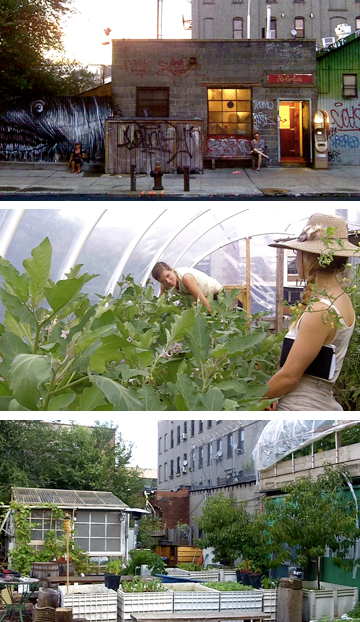Archive for September 2011
Brooklyn’s Roberta’s Pizza
A cinder block one-story building barely sets Roberta’s Pizza apart from the surrounding industrial landscape in the Bushwick section of Brooklyn. However, inside a fire roars in the wood-fired oven and five white-coated chefs slide pizzas in and out of the oven creating a warming and inviting environment. Wood paneling and casual decor encloses a bustling dining area. There are a few private tables, but most diners are grouped together at several large picnic tables. Two modest sized bars, one in the back and one outside boast a limited but good mix of the usual bar options with a few creative twists thrown in. An hour and a half wait for a two top table gave us some time to explore some of the more interesting aspects that set Roberta’s apart from your average pizza joint and makes it an epicenter of local food and culture in Brooklyn.
A quarter acre side lot houses Roberta’s kitchen garden, an outdoor oven, and gathering space. Melissa, Roberta’s farmer, manages the restaurant’s hyper-local food production. Portable container gardens, moved around with pallet jacks, are filled with a variety of herbs, greens, fig and apple trees, carrots, and a wild garden of borage whose cucumber essence flowers appeared later on our dessert. Seedlings are grown and tools are stored in a greenhouse constructed of a patchwork of repurposed windows.
After visiting the restaurant, Alice Waters, seasonal chef and children’s garden advocate, funded the construction of a hoophouse, which perches atop two shipping containers. The simple greenhouses extend the season for salad greens in the spring and fall and humid loving tomatoes and eggplants in the summer. An intelligent use of vertical space, the shipping containers house Heritage Radio Network, an independent radio station that broadcasts more than 21 shows that focus on an in-depth look at the food system.
The owners of Roberta’s Pizza have been a prominent voice in the urban farm movement. In addition to their own garden, they also source many ingredients from farmers markets and small specialty growers in the area. Roberta’s co-owners, Brandon Hoy and Chris Parachini, helped found The Grange, a rooftop farm in Long Island City, Queens and currently sit on the board of directors. The Grange has a Sunday farm stand at the restaurant.
Amidst the garden, self-identified “deep film nerd,” Gabe Soria, hosts a weekly outdoor movie night. The night we popped in the curatorial theme was “twisted rock musicals,” with a double header of Phantom of the Paradise and Purple Rain. Folks gather in tiki torch-lit, theater style seating to munch on $8 personal pizzas and imbibe cool summer drinks. Thursday night films plan to continue into the fall and winter so check Roberta’s website for future screenings.
Eventually we are seated at a rough-hewn wooden table and benches, and get a chance to peruse the menu which is subdivided into four categories: Salumi, Market/Garden, Pizza, and Kitchen. In order to experience the whole gamut, we decide to get a dish from each category.
A plate full of yellow and orange carrots arrived glistening in the dim light with smoked ricotta and garnished with one of my favorite mustard greens, “ruby streaks.” However, we had a hard time identifying the promised amaranth and our server unable to answer our question, kindly hurried off to the kitchen to find out from the chefs and returned with an answer that still left us wondering if we had actually eaten amaranth. Big fans of traditional foods, we were excited to taste sweetbread, a specially prepared gland. We were surprised when it came out breaded and fried and indulged happily in this contemporary take on comfort food but were wondering if the preparation negated the organ’s nutritious benefits. The Banana Hammock Pizza (béchamel, mozzarella, parmigiano, pork sausage, banana pepper, garlic, onion, cilantro on a thin crust) was a delicious combination of toppings and the hint of charred crust provided that authentic wood fired flavor. Always on the lookout for low sugar and gluten free desserts, the Avocado Semifreddo was especially intriguing. Of course, the tropical avocado and coconut swayed from the local theme, but the flavor was divine, the textures perfect in their contrast, and the borage flower garnish unified the pre-dinner, self-guided tour of the garden and the sensory satisfaction of a full belly and happy mouth.
Attentive staff that functions as a team with at least four servers dipping in to take orders and clear dishes kept the experience flowing. If you want to avoid the crowds, Roberta’s also has a delivery business, but the value-added experience of movie night in the kitchen garden really puts the “culture” back in agriculture in Brooklyn’s own very unique way (Sara Worden & Susan Hilvert, 9/6/11).
[Roberta’s, 261 Moore St., Brooklyn, 718.417.1118, Lunch and Dinner: Mon-Fri 12:00PM-Midnight, Sat-Sun 11:00AM-Midnight, www.robertaspizza.com]
What I Eat- Around the World in 25 Diets
The Museum of Science in Boston, Massachusetts [1 Science Park, Boston, Ma, 617.723.2500] is currently presenting “What I Eat- Around the World in 25 Diets,” a provocative exhibit of 25 individual “food portraits” created by the husband/wife team, photographer Peter Menzel and writer Faith D’Aluisio, on display until January 1, 2012 in the Museum’s Blue Wing, Level 2 [www.mos.org/exhibits_shows/current_exhibits&d=5019]. Although they are not practicing one of the fine arts, like painting or sculpting, this brilliant exhibit, consisting of photographic portraits of 25 people around the world, along with the depiction of the food eaten over the course of one particular day in the photograph’s foreground, has earned them the right to call themselves “artists.”
The artful portraits on display is the fruit of travel to 30 countries and more than a dozen states in the United States, and the tedious work, on the return of Menzel and A’Aluisio to their home in California’s Napa Valley, of transcribing countless hours of interviews of their subjects and then analyzing the ingredients of every food item in the photos so the calorie counts could be calculated. Their decision to exhibit the 25 food portraits according to the number of calories consumed, from least to most, captures the attention of any visitor to this must-see exhibit, and opens up an unstoppable conversation on the diversity of foods and diets that sustains the world’s population. The nature of this exhibit prompts many vigorous conversations among viewers, young and old, in the course of a visit to the gallery at the Museum of Science in Boston.
If you don’t have the opportunity of seeing this exhibition in person, “What I Eat- Around the World in 25 Diets” grew our of the publication last year of What I Eat, Around the World in 80 Diets by Peter Menzel and Faith D’Aluisio (Ten Speed Press, Berkeley, Ca., an imprint of the Crown Publishing Group, a division of Random House, Inc., New York, 2010) a lavish coffee-table sized book of 335 pages ($40.00), with a foreword by Marion Nestle, author of Food Politics and What to Eat, and a closing essay on The Pleasures of Eating by Wendell Berry, excerpted from his “What Are People For?.” Included in the 80 food portraits published in the companion book (but not on display in the Boston museum) is one of perhaps the most famous farmer in the United States, Joel Salatin of Swoope, Virginia, with his 3900 calories for one day. Farmer Salatin, who was profiled in Michael Pollan’s The Omnivore’s Dilemma (The Penguin Press, New York, New York, 2006), operates pasture-based Polyface Farms. Faith D’Aluisio describes the farm as “a holistic agricultural enterprise raising cattle, hogs, chickens, turkeys, rabbits-and grandchildren. By carefully managing and rotating pastures and animals (but not the grandchildren) in a pattern that naturally fertilizes and regenerates the earth, he raises healthy animals in humane environments without the need for chemical fertilizers.”
Any project that focuses on the diets of individuals around the world must address the issue of world hunger in some fashion. Only two of the 25 food portraits in the exhibit at the Museum of Science are of individuals without enough to eat: (1) 800 calories, Noolkisaruni Tarkuai, The Maasai Herder of Kenya, age 38, height 5′ 5″, weight 103 pounds, and (2) 1400 calories, Alamin Hasan, The Runaway Train Porter of Bangladesh, age 12, height 4’7″, weight 68 pounds. Included in the book on which the exhibit is based are also food portraits of two additional individuals with diets of inadequate calories: (1) 900 calories, Marble Moahi, The Caretaker of Botswana, age 32, height 5’5″, weight 92 pounds, and (2) 1000 calories, Sitarani Tyaagi, The Sadhu Priest, age 70, height 5’6″, weight 103 pounds. The solution for improving the diets of these underfed individuals is of course debatable, but the answer will not be found in the spread of processed junk food as noted in a recent report issued by the United Nations.
The exhibit captures effectively the “unwelcome transition from traditional foods to processed junk food as globalization expands” as noted by Marion Nestle in her foreword to the book by its careful detailing of the calories consumed by the individuals profiled. Wendell Berry reinforces this point in his closing essay included in the companion book: “The idea that every locality should be, as much as possible, the source of its own food makes several kinds of sense. The locally produced food supply is the most secure, the freshest, and the easiest for local consumers to know about and to influence.”
Indeed, the most disturbing food portrait is the diet of 12,300 calories of Jill McTighe of Great Britain. Ms. Tighe who struggles with binge eating consumed an extraordinary number of calories from highly processed food in the course of the one day depicted.
The 25 food portraits on display in Boston: (1) Kenya- 800 calories, Noolkisaruni Tarakuai, The Maasai Herder, (2) Bangladesh- 1400 calories, Alamin Hasan, The Runaway Train Porter, (3) China- 1600 calories, Xu Zhipeng, The Extreme Gamer, (4) United States-1700 calories, Mackenzie Wolfson, The Weight-Loss Camper, (5) China- 1700 calories, Cao Xiaoli, The Acrobat, (6) United States- 1900 calories, Tiffany Whitehead, The Mall of America Staffer, (7) United States- 2100 calories, Felipe Adams, The Iraq War Veteran, (8) Chad- 2300 calories, Abdel Kerim Aboubakar, The Teenage Refugee, (9) Iceland-2300 calories, Karel Karelsson, The Cod Fisherman, (10) United States- 2400 calories, Mariel Booth, The Fashion Model Student, (11) China- 2600 calories, Chen Zhen, The College Student, (12) United States- 2700 calories, Leland Melvin, The Astronaut, (13) Taiwan-2700 calories, Lin Hui-wen, The Street Food Vendor, (14) Yemen-2700 calories, Saada Haidar, The Homemaker, (15) India-3000 calories, Shashi Chandra Kanth, The Call Center Operator, (16) Egypt-3200 calories, Saleh Abdul Fadlallah, The Camel Broker, (17) Japan-3500 calories, Miyabiyama, The Sumo Wrestler, (18) Germany- 3700 calories, Robina Weiser-Linnartz, The Bread Queen, (19) Ecuador- 3800 calories, Maria Ermelinda Ayme Sichigalo, The Mountain Farmer, (20) Venezuela-4000 calories, Katherine Navas, The Student in the Barrio, (21) Germany-4600 calories, Markus Dirr, The Master Butcher, (22) Tibet-5600 calories, Karsal, The Yak Herder, (23) Venezuela-6000 calories, Oswaldo Gutierrez, The Oil Platform Chief, (24) Namibia-8400 calories, Tersius Bezuidenhout, The Trans-Kalahari Trucker, and (25) Great Britain-12300 calories, Jill McTighe, The Snacker Mom. [FW Barrie, 9/5/11]








